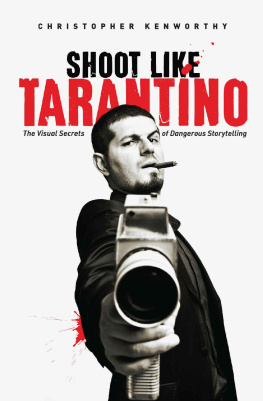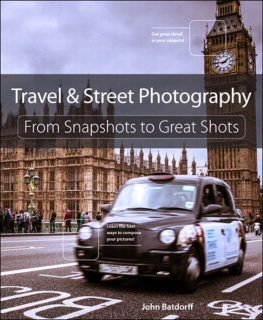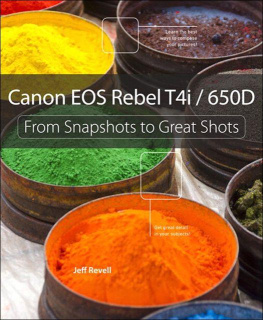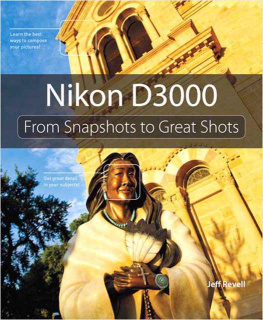A terrific sequel to the first Master Shots. If theres a cool way to move the camera, Christopher Kenworthy has explained it to us. I cant wait to get it in my students hands.
John Badham, director, Saturday Night Fever, WarGames; author, Ill Be in My Trailer
The most comprehensive and practical breakdown of shooting technique, Kenworthys Master Shots, Volume 2, is required bedside reading for anyone whos serious about making movies.
Neill D. Hicks, author, Screenwriting 101: The Essential Craft of Feature Film Writing; Writing the Action-Adventure Film: The Moment of Truth; and Writing the Thriller Film: The Terror Within
Christopher Kenworthys second volume of Master Shots will inspire every filmmaker to think carefully about placement and movement of actors as seen through the camera lens. This book increases the readers appreciation for the critical work of the cinematographer and the director as they speak the language of film through images.
Mary J. Schirmer, screenwriter, screenwriting instructor, www.screenplayers.net
Master Shots, Volume 2, is an inspiration for every director, cinematographer, and writer. When breaking down a script, I always have Master Shots laying open within arms reach.
Stanley D. Williams, PhD., executive producer, director, Ninevehs Crossing, LLC & SWC Films
Kenworthy has delivered one of the greatest no-filler books on camera technique Ive ever seen, pairing motivation and mechanics to achieve maximum visual impact. This isnt a book of glossary terms, its a game-changer.
Troy DeVolld, author, Reality TV: An Insiders Guide to TVs Hottest Market
Master Shots, Volume 2, tells you how to achieve powerful dialogue scenes. Each explanation is clearly and simply illustrated by stills from popular movies. Computer-generated illustrations accompany each scene to show exactly where to place the camera. Master Shots, Volume 2 is brilliant. A must-have companion to the first Master Shots.
Tony Levelle, author, Digital Video Secrets
Any director should read this book to get a feel of the scope of potential in shooting dialogue. And if you can convince your actors to read it as well, finally everyone will be on the same page on set.
Erin Corrado, onemoviefivereviews.com
This encyclopedia of 100 industry-standard master shots tells you how to best communicate any storytelling idea through framing, positioning, and dynamic movement. And it doesnt just tell you how, but why. After reading this book youll never neglect the importance of that living and breathing, yet invisible actor in every scene: the camera.
Carl King, author, So, Youre a Creative Genius... Now What?

Published by Michael Wiese Productions
12400 Ventura Blvd. #1111
Studio City, CA 91604
(818) 379-8799, (818) 986-3408 (FAX)
www.mwp.com
Cover design by Johnny Ink. www.johnnyink.com
Interior design by William Morosi
Edited by David Wright
Printed by McNaughton & Gunn
Manufactured in the United States of America
Copyright 2011 by Christopher Kenworthy
All rights reserved. No part of this book may be reproduced in any form or by any means without permission in writing from the author, except for the inclusion of brief quotations in a review.
Library of Congress Cataloging-in-Publication Data
Kenworthy, Christopher.
Master shots, volume 2 : 100 ways to shoot great dialogue / Christopher Kenworthy.
-- 2nd ed.
p. cm.
Original ed. published in 2009.
ISBN 978-1-61593-055-5 (pbk.)
1. Cinematography. 2. Motion pictures--Production and direction. 3. Dialogue in
motion pictures. I. Title. II. Title: Master shots, volume two.
TR850.K46 2011
777--dc23
2011016837
Printed on Recycled Stock
CONTENTS
INTRODUCTION
Many people think that feature films look cinematic because their budget was large. What I hope to show through the Master Shots books is that the cinematic look costs nothing. A strong scene is about where you put the camera and how you position and direct your actors. This is especially true when shooting dialogue.
With the skills you will learn in Master Shots, Volume 2, you can make your dialogue as strong as it deserves to be, so that every plot point, every emotion, and every subtle meaning is communicated clearly, while you draw the best performances out of your actors.
When the original Master Shots was first published, it immediately received strong reviews and rapidly became a bestseller. I received countless emails from filmmakers who said the book had opened their eyes to setting up shots. Many said they never knew so much thought went into setting up a shot. Others said they didnt know one camera setup could work on so many levels. It was gratifying to know that filmmakers were willing to delve deeper than ever into their craft.
Within a few months the book became a big hit at film schools, and I was soon watching many student films that had been improved by the advice in my book. Filmmakers who won awards wrote to tell me how Master Shots had helped. To my great surprise, a handful of Hollywood directors (who Id admired for decades) wrote to tell me how much the book had helped them. One director even told me hed never go to set without my book in his hand.
Master Shots didnt just present 100 shots that people could copy. It opened filmmakers eyes to the techniques that achieve the best effects. It encouraged them to combine these shots in new ways, to make up their own moves. Despite this, there was one theme that kept coming up over and over again when people wrote to me. They nearly all asked, Whats the best way to shoot dialogue? Your film cannot work without good dialogue scenes, so Master Shots, Volume 2, offers you the critical techniques needed to bring dialogue to life.
Although the original Master Shots covers dialogue in many chapters, it is not specifically about dialogue. Since writing the first Master Shots book, I have directed a feature film and worked on many other projects, and I became obsessed with shooting dialogue in interesting ways. More importantly, I wanted to find methods to shoot dialogue in a way that captures the essence of the script. I watched hundreds and hundreds of films to research this book. Every one of the films included here contains good dialogue scenes, and all are worth watching in their entirety.
Unfortunately, many scenes in blockbuster feature films dont make the most of the dialogue found in the screenplay. As the scene opens, the camera soars through a graceful master shot, and then everything stops. The camera stops, the actors stand still and face each other, and the dialogue begins. Many movie conversations are as dull as this, but they neednt be. The best directors know how to position the camera and the actors to fully explore and express the scene.
These images illustrate standard setup, with one actor facing the other, both shot from the same distance and the same angle. In this book Ill refer to this setup as angle/reverse angle.

The angle/reverse angle setup is what results when time is short, people are tired, or the director has run out of ideas. Its okay, it works reasonably well, but its dull. There are many directors out there striving to stand out from the crowd, but when they come to shoot their dialogue scenes, this standard setup is what they shoot.










